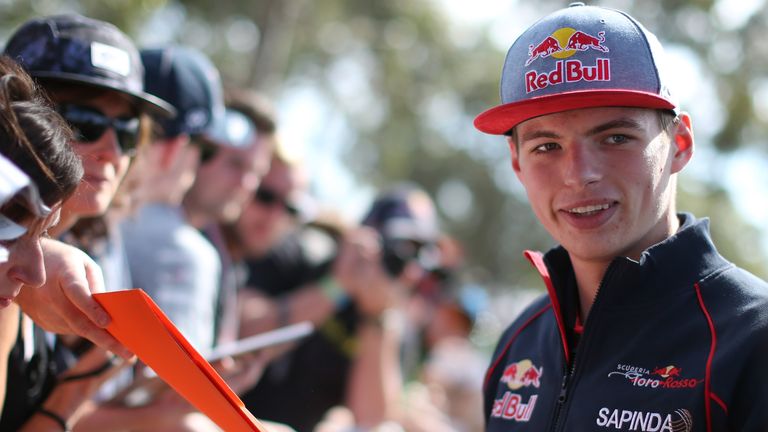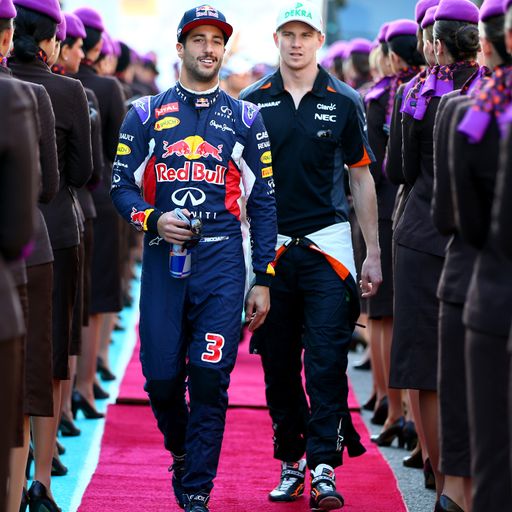2015 peaks point to Max Verstappen's great potential
Sky Sports F1's Mark Hughes scrutinises Max Verstappen's debut season in F1 and explains why the youngster justified the hype
Tuesday 8 December 2015 11:05, UK
There's obviously a great deal of hype and expectation around Max Verstappen, the teenage F1 prodigy.
And although it would be fair to say that he has comfortably won rookie of the year honours, those who were expecting an astonishing Schumacher or Senna-style redefining of F1's status quo in his first year have maybe been left slightly disappointed. But that was always an unfair expectation.
They were vastly more experienced than Verstappen when they made their stunning impact upon F1. Verstappen's peaks - his stunning passes in China, Spa and Brazil, his second fastest time in practice on his first visit to Monaco, his great composed fourth places in Hungary and Austin - were absolutely of that level. But there were more dips in between and his pace advantage over his rookie team-mate Carlos Sainz was not overwhelming. As a rookie, Schumacher out-performed a triple world champion team-mate immediately and consistently, Senna took a mid-grid car into podium contention and almost won Monaco. A rookie Lewis Hamilton generally had a small performance advantage over double champion Fernando Alonso. But this is not comparing like with like.
It's simply the only way it could ever play out with a driver whose data banks were relatively empty in just his second season of car racing and in an F1 where you can no longer test for weeks upon weeks, racking up thousands of miles before your debut. Verstappen has spent the 2015 season filling in those holes. The graft of that routine learning - of systems, of how to get the best from himself and others, of understanding what you can and can't do with the tyres, the brake-by-wire, the set-up limitations of the car etc - are what will fill in the gaps and make him the racing driver his outstanding peaks promise.
At a record-breaking 17-years old when he made his debut - he turned 18 in the weekend of the Japanese Grand Prix - he did far more than show he was worthy of a place in F1. Had Melbourne played out the way it was going to before his Toro Rosso's engine stopped immediately after his pit stop, he would have caused a minor sensation. His drive was relatively unnoticed because he ran the first stint on the prime tyres while those around him were on the options. He had managed to maintain a fantastic pace to keep the option-tyred cars behind him and was set to get the payback for that in the next stint when he'd switched to the faster tyres and all those around him were on the slower rubber.
"Although his drive in China created all the headlines because of the fantastic overtakes, actually his drive in Melbourne was even better." says Toro Rosso team boss Franz Tost. "He was driving as fast as was necessary that the others could not overtake him but not overworking the tyres and the lap times he was doing on those tyres were fantastic. He would for certain have finished sixth or seventh. It was a fantastically controlled drive. He has a great sensitivity for the tyre but is also able to react immediately. If he feels that he overworks the tyre then next corner he finds a solution, doesn't just continue to push in the same way; he finds a way not to lose too much time but save the tyre. Normally a driver needs minimum one year experience for this."
Sensitivity is in fact what marks out Verstappen as an extraordinary driver. It's that quality that gives him the tyre feel, just as it gives him the balancing point of the car, allowing him to sit it just on that pivot of entry speed and tyre scrub, allows him to make those extraordinary passes. There are many successful F1 drivers who have never completed the sort of moves Verstappen pulled off in just his third Grand Prix several times. Those moves in Shanghai would come to be his trademark: from a long way back, he simply ambushes the car ahead, takes the other guy by surprise. He has the car sliding and scrubbing off speed as he's alongside, but without letting that slide develop and by the time he's ready to make for the apex, it's all been brought neatly back in line and there's not even been a whiff of tyre smoke.
Partly this is because he gets the car rotated very soon into the corner anyway. Compared to other drivers, his car has made most of its attitude change much earlier in the corner, well before the apex. It's the way that the quick kart racers drive their karts - but in a kart it's much easier to do because there is so little weight and momentum to that shallow rear end slide, using the slide to help turn the car/kart earlier, requiring less steering. To be able to carry that technique as a matter of course into an F1 car tells of an amazing talent. As well as giving him a formidable overtaking weapon, what that technique also does is allow him to get earlier on the power and to save on front tyre wear by not needing as much steering lock.
His pass on Felipe Nasr through the flat-out Blanchimont corner during the Belgian Grand Prix was nothing to do with that, however. It was about astonishing judgement and bravery. The consequences at around 190mph if that move had gone wrong would have been horrific. His move in Perez through the Senna Esses in Brazil was just more of what we'd already seen in Shanghai.
The gaps in the data banks were evident in his patchy qualifying performances - these much more evident in the first half of the season than the second, indicative of his progress. Often a level of brutality with the tyres is necessary over the one-lap challenge of qualifying - and this was counter-intuitive for him. Finding the balancing point between the necessary aggression to get the tyres instantly working and over-aggression that simply costs lap time wasn't easy for him - and in this his more experienced team-mate Sainz (in his sixth season of car racing rather than his second) was initially more adept.
Taking the half-season up to Silverstone, Sainz - who had a hugely impressive debut season himself - legitimately out-qualified Verstappen six times to three. In the latter half-season, and taking out those races where engine and other problems for one or the other of them made comparison impossible, Verstappen was ahead four times to two.
Verstappen is an amazing talent and it's important to remember that it's the peaks rather than the averages that are more indicative of potential in a driver's early career.
MH






